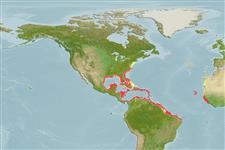>
Anguilliformes (Eels and morays) >
Muraenidae (Moray eels) > Muraeninae
Etymology: Gymnothorax: Greek, gymnos = naked + Greek, thorax, -akos = breast (Ref. 45335).
Environment: milieu / climate zone / depth range / distribution range
Ecología
marino asociado a arrecife; rango de profundidad 1 - 50 m (Ref. 58047), usually 5 - 30 m (Ref. 26938). Tropical; 42°N - 30°S, 99°W - 13°W (Ref. 55256)
Western Atlantic: New Jersey (USA), Bermuda, and northern Gulf of Mexico to Brazil. Recorded once from Nova Scotia, Canada. Eastern Atlantic and eastern Pacific (Ref. 26340).
Tamaño / Peso / Age
Maturity: Lm ? range ? - ? cm
Max length : 250 cm TL macho / no sexado; (Ref. 7251); common length : 150 cm TL macho / no sexado; (Ref. 5217); peso máximo publicado: 29.0 kg (Ref. 9710)
Short description
Morfología | Morfometría
Very large brown moray, uniformly dark green to brown (Ref. 26938).
A benthic and solitary species (Ref. 26340) occurring along rocky shorelines, reefs, and mangroves (Ref. 3255).Usually found shallower than 30 m (Ref. 26938). Due to its large size and aggressiveness, the bites of this moray are particularly dangerous (Ref. 3255). Feeds mainly at night on fish and crustaceans (Ref. 42064). Marketed fresh and salted (Ref. 3255). Large individuals are ciguatoxic (Ref. 3255).
Life cycle and mating behavior
Madurez | Reproducción | Puesta | Huevos | Fecundidad | Larva
Spawning migrations and leptocephalus larvae (ref. 42064).
Robins, C.R. and G.C. Ray, 1986. A field guide to Atlantic coast fishes of North America. Houghton Mifflin Company, Boston, U.S.A. 354 p. (Ref. 7251)
IUCN Red List Status (Ref. 130435)
Threat to humans
Traumatogenic (Ref. 3255)
Human uses
Pesquerías: escaso valor comercial; Acuario: Acuarios públicos
Más información
ReferenciasAcuiculturaPerfil de acuiculturaRazasGenéticaElectrophoresesheritabilidadEnfermedadesProcesamientoNutrientsMass conversion
Herramientas
Special reports
Download XML
Fuentes de Internet
Estimates based on models
Preferred temperature (Ref.
123201): 23.3 - 28, mean 26 °C (based on 476 cells).
Phylogenetic diversity index (Ref.
82804): PD
50 = 0.5000 [Uniqueness, from 0.5 = low to 2.0 = high].
Bayesian length-weight: a=0.00062 (0.00041 - 0.00093), b=3.27 (3.15 - 3.39), in cm total length, based on LWR estimates for this species & Genus-body shape (Ref.
93245).
Nivel trófico (Ref.
69278): 4.0 ±0.71 se; based on food items.
Resiliencia (Ref.
120179): Muy bajo, población duplicada en un tiempo mínimo superior a 14 años (Preliminary K or Fecundity.).
Fishing Vulnerability (Ref.
59153): Very high vulnerability (90 of 100).
Nutrients (Ref.
124155): Calcium = 16 [8, 25] mg/100g; Iron = 0.4 [0.2, 0.8] mg/100g; Protein = 18.7 [16.4, 21.3] %; Omega3 = 0.0823 [, ] g/100g; Selenium = 60.6 [27.2, 130.1] μg/100g; VitaminA = 56.2 [13.7, 218.4] μg/100g; Zinc = 0.72 [0.49, 1.05] mg/100g (wet weight);
